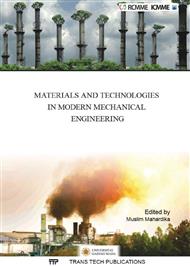p.3
p.7
p.14
p.19
p.24
p.31
p.36
p.43
p.53
Optimization of Cutting Parameters Based on Specific Cutting Energy Consumption for Aluminum 6010 by Using the Analysis of Variance (ANOVA)
Abstract:
Manufacturing industries have consumed 30% of the total world energy. The main energy source used in those manufacturing industries is the electricity generated from fossil fuels such as oil, gas, and coal as a result in causing the environmental and economic issues. This paper presents an experimental study in order to get the minimum energy consumption during turning of aluminum 6010 with the conventional machine tool under dry cutting condition by optimizing the cutting parameters to contribute to those issues. An analysis of variance (ANOVA) was employed to analyze the effects and contribution of depth of cut, feed, and cutting speed on the response variable, specific cutting energy. The result of this experiment showed that the feed was the most significant factor for minimizing energy consumption followed by the cutting speed and the depth of cut. The minimum energy consumption was obtained when the highest level of cutting parameters have been used.
Info:
Periodical:
Pages:
14-18
Citation:
Online since:
June 2016
Price:
Сopyright:
© 2016 Trans Tech Publications Ltd. All Rights Reserved
Share:
Citation:


